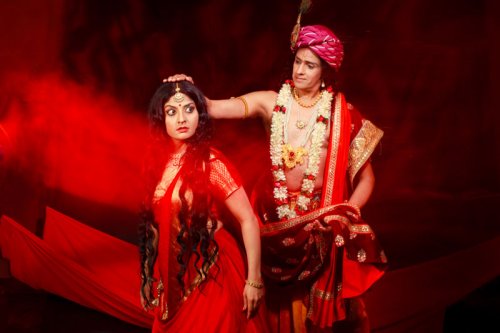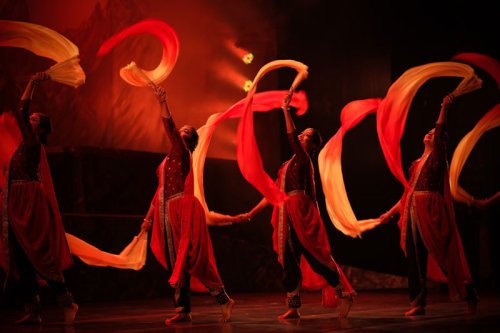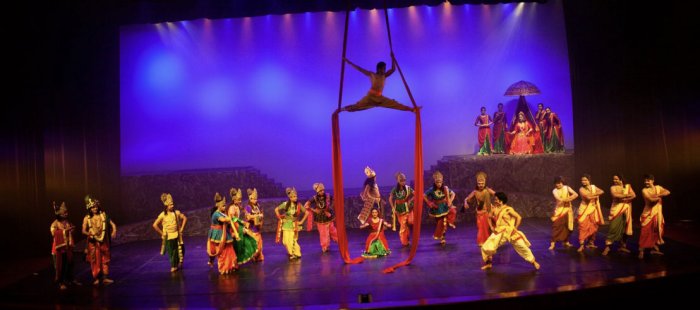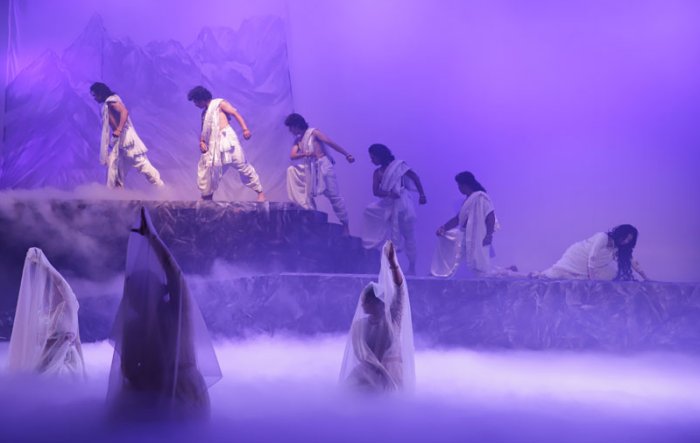
|   |

|   |
Krishnaa - Fire to Frost - Arjun Bharadwaj e-mail: arjunbharadwaj@gmail.com Photos: Arvind Shenoy, Nagaraj Somayaji August 10, 2019 Art connoisseurs of Bangalore recently got the taste of what could be called a classical spectacle. The Abhinava Dance Company under the creative direction of Nirupama Rajendra and T.D Rajendra premiered their latest production 'Krishnaa -Fire to Frost.' The theme was suggested by Sudha Murthy, Chairperson, Infosys foundation, a humanitarian and a patron of arts. Shatavadhani Dr. R. Ganesh, a creative genius, developed the concept with his astute sense of aesthetics and propriety, without compromising on the vision of Vyasa, the author of the epic Mahabharata. Dr. Ganesh also penned the lyrics in Kannada and suggested ways in which the concept could be executed audio-visually. Praveen D. Rao was at the helm of the music production team, which consisted of a spectrum of versatile and talented artists. The lead singers were Siddhartha Belmannu and M.D. Pallavi.   The very title of the program subtly suggests the emotional journey of Draupadi, the tragic heroine of the grandest epic of India, the Mahabharata. Her coming to the earth was through fire, a bright and agile invigorating element which cooled down and solidified into ice, i.e., water devoid of its dynamism. Draupadi has 'Krishna' in her name and in her heart - he is the substratum of her life. The theme is indeed baffling for any dancer, who knows the emotional landscape that the wife of the five Pandava brothers goes through and is very challenging to bring out through classical dance, as most of Draupadi's life is filled with elements of pathos, rage and disgust. The rasa-raja, sringara, the driving force for any stylized dance form of India, seems to have played only a peripheral role in Draupadi's life. The production, however, proved beyond doubt that these apparent constraints were effortlessly transcended by Nirupama and Rajendra, by their impeccable talent and sheer hard work. Dr. Padma Subrahmanyam, who was one of the chief guests for the premiere show rightly called it 'A Bharata-natyam production in the truest sense', i.e., a wholesome theatrical experience as per the tenets set down by Bharata. Each element of the Caturvidhabhinaya found expression to the fullest extent and the attention to detail is hard to capture in words.  The second half of the production presented Durvasa visiting the Pandavas in the forest, Krishna's akshaya-patra miracle, Draupadi abused by Kichaka and Bhima's combat with the lustful villain, the preparation for the Kurukshetra war and the ascent of the Pandavas and Draupadi to svarga. While the original epic ends on a note filled with pathos as Draupadi falls down during the Svargarohana and Yudhishthira hurls an unsympathetic judgement on her character, the production 'Krishnaa' ended on a note filled with hope, peace and contentment. As Draupadi falls off, it is Krishna who comes and holds her up, just as he has been by her side, lifting her up whenever she was down. As art is a magnifying glass into emotions and a slow motion of life, the production zoomed into a few less known, but profound segments from the popular regional retellings of the Mahabharata. In one such sequence, Krishna playfully cuts off his finger during the rajasuya-yaga. While his wives, sisters, mother, aunt and all other women in the court are unsure how to react, Draupadi comes forward, tears her royal gown and bandages Krishna's bleeding finger. Krishna promises that this display of affection will manifest a millionfold whenever she is in need (and this is a prequel to the infinite saree that Krishna blesses her with). In another sequence, Draupadi has a conversation with Satyabhama, who is curious to know how she has managed to win the affection of five husbands at a time while several women together haven't been able to win over Krishna. Draupadi explains how her love for all the husbands is unbiased and untainted. She caters to the interests and passions of each of them and actively participates in their pursuits. Yet another detail that was captured was the episode where Draupadi admonishes Bhima and the other brothers as they are wary of waging a war. Just before Krishna heads to the Kaurava court for a conversation, the Pandavas say that they would prefer peace to war. An enraged Draupadi then proposes that her husbands sit behind walls wearing bangles, while she is ready to fight the war herself with her brother, father and children. These intensely emotional sequences captured the hearts of the connoisseurs.  A sequence that lightened the hearts of the rasikas amidst several touching segments was the Sringarabhasa that Kichaka experiences with Bhima who is disguised as Draupadi. The sequence stood as a testimony to Bharata's view that caricature of sringara can give rise to hasya (Sringaraddhi bhavet hasyam!). There was also a scintillating sequence of a brilliant Brhannala teaching dance to Uttara. The lyrics were filled with alliterations, typical to Dr. Ganesh's exuberant style. The functional music helped deepen emotions. The colours of costume, background and lighting constantly suggested the sthayi-bhava and intensified the experience. With minimal usage of stage properties, the artists created different environs just by their talent and abhinaya. What fascinated the rasikas most was the seamless blend of the classical styles of Kathak and Bharatanatyam interspersed with aesthetic adaptions of the movement vocabulary of the Natyasastra- the Karanas. The production established beyond doubt that this movement vocabulary transcends time and can render itself for the depiction of any character or event in a theatrical production. In Dr. Padma Subrahmanyam's words, the production had reached perfection in all its dimensions. The production consisted of thirty-five dancers on stage playing various roles. The primary characters were played by Ashwin Prabhath (Kichaka), Nidhag Karunad (Yudhishṭhira), Anil Iyer (Bhima) Somashekar (Arjuna and Brhannala), Naveen Hegde (Nakula), Darshan (Sahadeva), Rohini Prabath (Satyabhama and Uttara), Smruthi Vishwanath (Rukmini), Aditi Ashok (Subhadra) and Abhilash Udupa (multiple roles). Lighting was designed and handled by Ajay Vijayendra and sound was engineered by T.D. Srinivas. Arjun Bharadwaj is a poet, translator, engineer and musician. He is a polyglot, well-versed in Sanskrit, Kannada, English, Greek, and German. Arjun is currently studying comparative aesthetics of classical Greek and Sanskrit literature. He often composes lyrics for dancers and delivers lectures on arts and aesthetics. He currently serves as an Assistant Professor at Amrita Darshanam - International Centre for Spiritual Studies, Amrita Vishwa Vidyapeetham, Bangalore. |